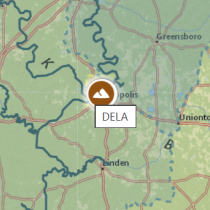Success for NEON: A $433M Slot in Obama’s Budget Plans
February 2, 2010
NEON staff and colleagues celebrated a major achievement on Monday when the Obama Administration’s Fiscal Year (FY) 2011 budget request to Congress was unveiled. NEON has been included in the National Science Foundation’s Major Research Equipment and Facilities Construction (MREFC) budget for a full construction cost of $433.72 million. The Administration’s proposed budget plan has allotted $7.4 billion for the National Science Foundation (NSF), an 8% increase over the 2010 enacted level, as part of the President's Plan for Science and Innovation. The FY 2011 Budget Submission for NEON is $20 million, which represents the first year of a five-year project that spans six fiscal years (proposed total cost chart provided below, courtesy of NSF MREFC Budget Submission).
NEON plans to build 62 sites across the U.S. by 2016 that will provide information about the impacts of climate change, land use change and invasive species on natural resources and biodiversity. NEON’s continental-scale design will provide ecological data products, data management, and data standardization, which will support basic research for modeling and understanding rates of environmental change on regional and continental scales. “This is a great affirmation of the decades of work put in by the scientific community, and a win for science in general, said David Schimel, NEON CEO. “NEON and its partners in science, education, and environmental management and stewardship will create new opportunities for understanding, predicting and responding to environmental change on a grand scale.” According to the NSF Budget Submission, recent assessments indicate that U.S. ecosystems will experience abrupt and unpredictable changes due to human causes in the near future. The Administration has identified these issues as among the most important, demanding, and urgent global problems of our time. Scientific discovery and science-based decision making are critical to selecting mitigation and adaptation policies and strategies so that we can preserve our national resources, economic vitality, health, quality of life, and national security supports. NEON is the platform to provide the scientific foundation needed to address these environmental challenges.
With a proposed construction start for FY 2011, NEON will provide an unprecedented opportunity to detect environmental signals as early as FY 2012. NEON Project Manager Tony Beasley said, "This is a promising step forward for NEON. We hope to complete the approval process for the Observatory later this year, and begin construction in 2011.” In order for a project to be considered for MREFC funding, NSF requires that it represent an exceptional opportunity that enables research and education. In addition, the project should be transformative in nature in that it should have the potential to shift the paradigm in scientific understanding. The projects included in this budget request meet these criteria based on NSF and National Science Board (NSB) review. A Preliminary Design Review (PDR) and Final Design Review (FDR) of NEON were successfully completed in June 2009 and November 2009, respectively. Project planning for NEON will continue through FY 2010 and construction is scheduled to begin in 2011 upon approval by the National Science Board. As a continental research instrument, NEON will support a large and diverse group of organizations and individuals. NEON will be the first observatory of its kind to collect data that will help scientists forecast ecological change at continental scales over multiple decades. NEON will utilize cutting-edge technology to gather and synthesize data from each of its 62 sites, as well as data from airborne observations, experiments, and land use studies.
